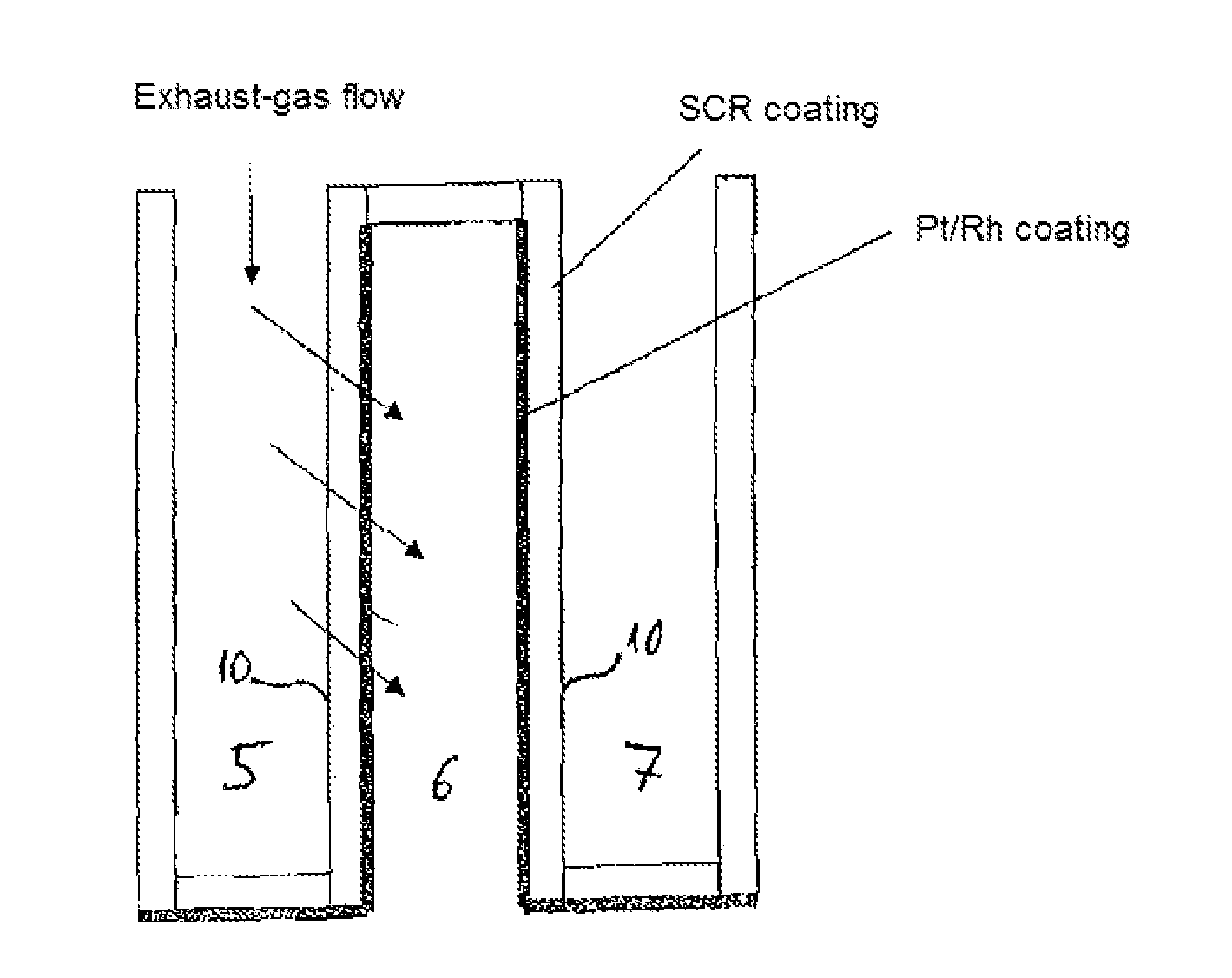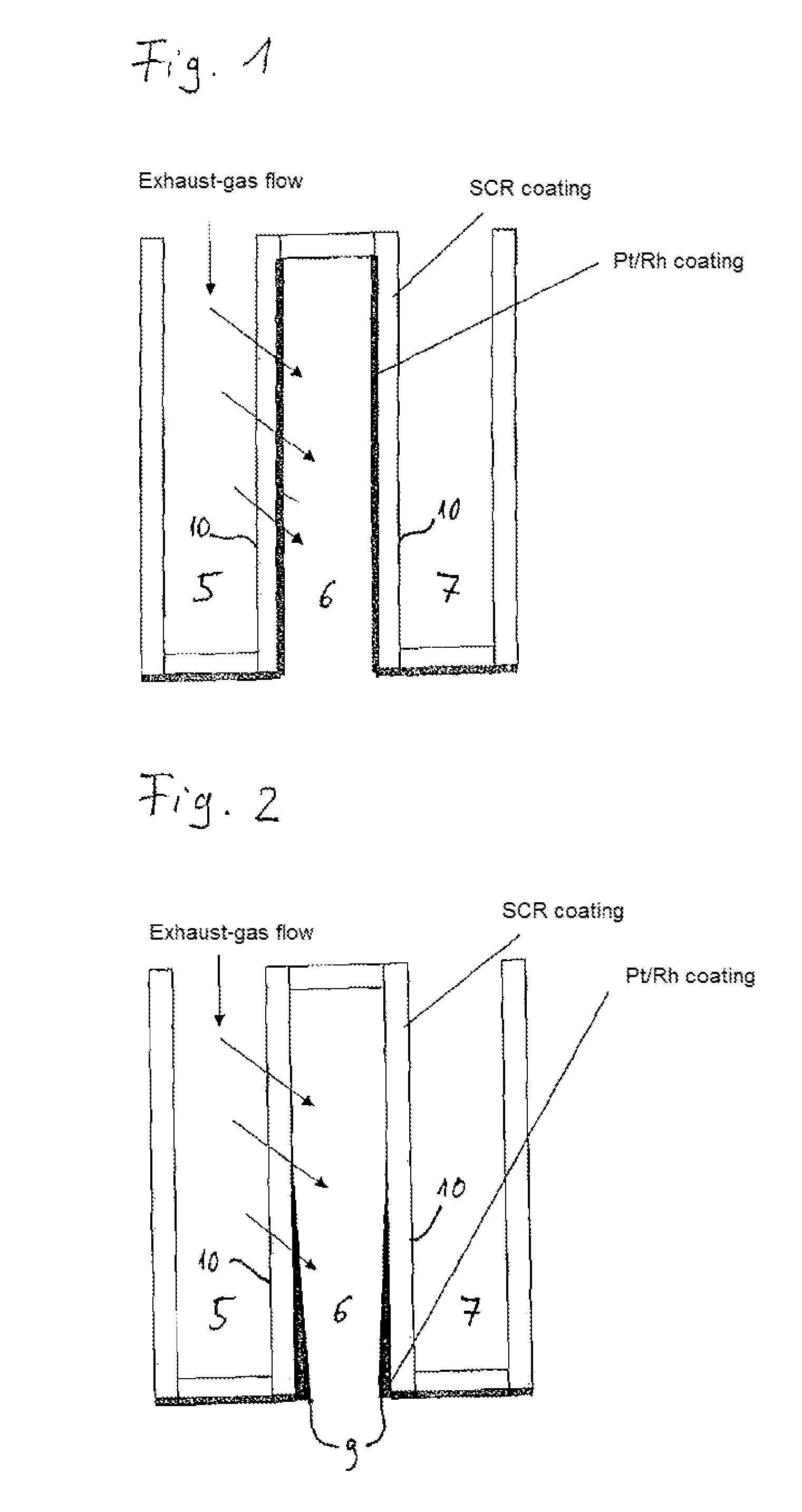Particle reduction with combined SCR and NH3 slip catalyst
a technology of slip catalyst and particle reduction, which is applied in the direction of metal/metal-oxide/metal-hydroxide catalyst, machine/engine, arsenic compound, etc., can solve the problems of carbon black spontaneous combustion, safety risk of use of compressed gas bottles, and not the filtration of soot particles, so as to increase the stability of aluminium oxide surfaces
- Summary
- Abstract
- Description
- Claims
- Application Information
AI Technical Summary
Benefits of technology
Problems solved by technology
Method used
Image
Examples
example 1
[0071]FIG. 1 shows a schematic representation of a diesel particle filter, designed as wall-flow filter with three adjacent flow ducts 5, 6, 7. A monolithic cordierite support with 600 cpsi and an approximate pore diameter of 10 μm serves as carrier body. Duct 6 is closed in the direction of the exhaust-gas entry side and the ducts 5 and 7 are closed in the direction of the exhaust-gas exit side. The porous carrier body is coated with an ZSM-5 type Fe zeolite on the exhaust-gas entry surface 10 and the inner surface of the porous cordierite monolith. The exhaust-gas exit surface 9 has a Pt / Rh coating which is distributed over the entire exhaust-gas exit surface. The engine-combustion exhaust gas enters the ducts 5 and 7 and, as these are closed at the end, is forced to flow through the cordierite support coated with an SCR active component into the flow duct 6. In the process the SCR reaction takes place. Upon exiting the cordierite support the treated exhaust gas strikes the platin...
example 2
[0074]FIG. 2 shows an analogous particle filter comprising a cordierite monolith with 600 cpsi and a pore diameter of approximately 10 μm. Here, too, the ducts 5 and 7 are closed in the direction of the areas facing the exhaust-gas exit side and the duct 6 closed in the direction of the side facing the exhaust-gas entry side. Here, too, the exhaust gas is forced through the cordierite support coated with an SCR active component (ZSM-5 type Fe zeolite) to flow through the porous wall. The catalytic SCR reaction again takes place there. A Pt / Rh coating, however, present only as partial coating and also with a gradient, is located on the exhaust-gas exit surface 9. In other words, the layer thickness and thus the noble-metal charge increase in the direction of the exhaust-gas exit side. With this catalyst system also, an adequate conversion of NOx to N2 is achieved by the SCR active coating.
[0075]Excess NH3 in normal operation is likewise oxidized to nitrogen by the oxidation catalyst ...
PUM
| Property | Measurement | Unit |
|---|---|---|
| temperatures | aaaaa | aaaaa |
| temperatures | aaaaa | aaaaa |
| temperatures | aaaaa | aaaaa |
Abstract
Description
Claims
Application Information
 Login to View More
Login to View More - R&D
- Intellectual Property
- Life Sciences
- Materials
- Tech Scout
- Unparalleled Data Quality
- Higher Quality Content
- 60% Fewer Hallucinations
Browse by: Latest US Patents, China's latest patents, Technical Efficacy Thesaurus, Application Domain, Technology Topic, Popular Technical Reports.
© 2025 PatSnap. All rights reserved.Legal|Privacy policy|Modern Slavery Act Transparency Statement|Sitemap|About US| Contact US: help@patsnap.com


